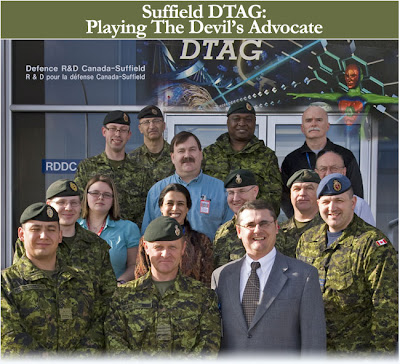This article led our internal electronic news service for Defence R&D Canada, but since it is internal and not generally available outside our intranet I thought I would post it as an example of an activity I recently did at work. (For those who can't tell, I am the guy with the blue shirt in the middle of the photo.)
Pictured here are military officers from CFB Suffield and DRDC Suffield, along with scientific personnel who participated in the inaugural Disruptive Technology Assessment Game (DTAG) held on March 3 and 10, 2010. This adapted-for-Canada, two part war game was the first of its kind which brought the Canadian Forces and defence scientists together to identify and assess the disruptive potential of technologies.
Defence scientists may spend weeks, months, and sometimes years exploring technologies that can give the Canadian Forces an advantage. A common question lingers, "how can we be sure this technology can deliver in reality what the CF needs to be ahead of the curve?" This quandary can be a source of consternation for both scientists and military personnel alike - particularly as it relates to disruptive technologies which give the military an operational advantage and competitive edge over adversaries.
As a solution to this complex issue, a Disruptive Technology Assessment Game (DTAG) was organized at DRDC Suffield on March 3 and 10, 2010 by Dr. Gitanjali Adlakha-Hutcheon while on assignment at Suffield from the Office of Chief Scientist, DRDC.
"DTAG serves as a tool for red-teaming using a mock scenario where blue and red teams square off. Each team is armed with futuristic technologies which are depicted by playing cards called Idea of Systems (IoS)," explains Dr. Adlakha-Hutcheon the DTAG organizer and chair. She elaborates, "Playing out these cards enables DRDC and the CF to play the Devil's advocate and evaluate the strengths and weakness of new technologies within military concepts of operations."

The Suffield DTAG was divided into two parts. Part One was designed to identify the IoS cards (technologies) expected to have the potential to disrupt the blue or red team's concept of operations (CONOPs). Part Two took place a week later using the traditional NATO DTAG style to play out the IoS cards to assess their disruptive abilities.
Part One - March 3: Two purple teams comprised of defence scientists and engineers came together for a structured brainstorming session. In a race against the clock the teams produced IoS cards to support a blue team mission. A panel of judges then decided which cards could pose the red team with the greatest number of rebuttals. During this exercise these IoS cards were challenged by military officers who red-teamed (a military term for acting as a challenge function) the exercise. After a rigorous challenge, four cards were finally selected to be played out for DTAG, Part Two.
Part Two - March 10: Eight military officers from CFB Suffield and DRDC Suffield, along with two scientific advisors were divided into a red team and a blue team. Executed over four sessions, this game used a single vignette made up of several asymmetric elements. In session one each team developed a CONOPs. The red team and blue team then faced-off in session two for a military confrontation chaired by LCol Dan Drew, Senior Military Officer, DRDC Suffield. In session three the IoS cards were introduced, forcing both teams to re-focus their CONOPs. The fourth session, was the battle royal with a technology-led confrontation between the two teams which was chaired by Dr. Scott Duncan, DRDC Suffield.
Participants really got into the game and the results reflected this commitment. Part One was valuable as it brought awareness among S&T professionals for DTAG as a tool for structured red-teaming. Part Two clearly identified technological systems requiring further exploration by DRDC in its role as trusted advisor and risk mitigator to optimize the benefits for the CF. The DTAG was formally wrapped up with a report to DG, DRDC Suffield.
Original Article: Leo Online 19 March 2010
Original Article: Leo Online 19 March 2010


No comments:
Post a Comment